Supremacy of Netflix, Amazon and Hulu Set to Weaken in 2020?
Published on 25 Feb, 2020
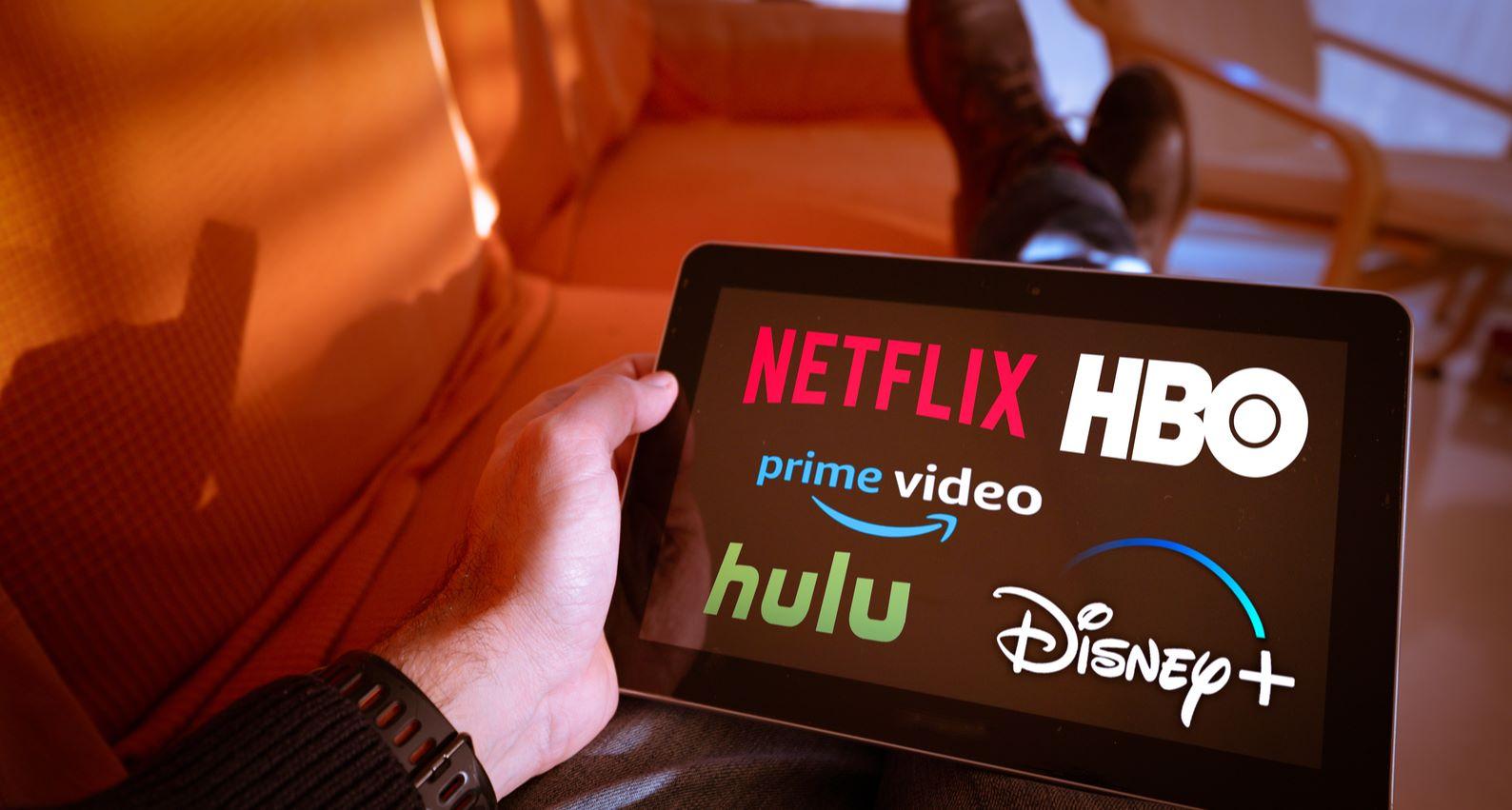
Introduced just a decade ago, video streaming is set to replace conventional cable TV, which has existed for almost seven decades in the US. Over the past years, early entrants such as Netflix, Amazon (Prime Video) and Hulu have acquired significant market share in the online streaming universe in the US. To tap into this revolutionary growth, giants from tech and media world, such as Disney, Apple, Comcast and AT&T, are entering the market, launching a streaming war of sorts.
Rise of streaming industry
Internet video streaming has grown rapidly over the past decade, expansion being nothing short of a revolution. YouTube, in 2005, laid the foundation by uploading the first video on its site. In 2006, Amazon introduced video on demand service. Netflix and Hulu followed suit, entering the video streaming market in 2007 and 2008, respectively.
Netflix, which started with just 1000 titles, took an early lead in gaining market share by aggressively acquiring rights of popular TV shows and movies. Amazon and Hulu were quick to realize the importance of content and started increasing titles in their library, albeit less aggressively. With the rising popularity of streaming services, industry players also started creating original shows exclusively for their own platform. In 2012, Hulu released its first original title, Battleground. 2013 became the landmark year for streaming as Netflix aired its first ever original title, House of Cards (HoC). The show received 33 Primetime Emmy Award nominations. The success of HoC prompted Netflix and other streaming providers to launch other more original content. This triggered the shift in consumer preference in the US to streaming platforms from cable TV.
Increasing use of smartphones and tablets opened a new avenue for gaining subscribers. In 2010, Netflix launched its mobile application for android and iPhone users. Other players followed, introducing their mobile applications in subsequent years. Amid growing popularity and easy accessibility of online content, millennials are switching to online streaming services in what can be termed as cutting the cord with conventional cable TV.
Timeline of streaming services
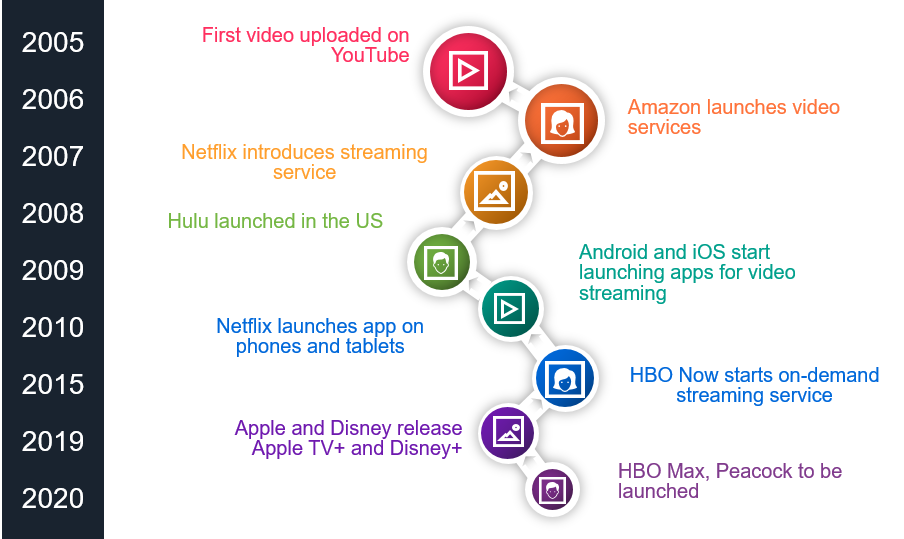
Source: Company Websites
Entry of tech and media giants
Over the last five years (2014–19), cable TV has increasingly lost customers to streaming. Taking cognizance of the new trend, many media and tech giants in the US have made a beeline for streaming. In 2019 alone, Apple and Disney have launched their streaming platforms, while Comcast and AT&T will enter the market in mid-2020. The industry, mainly dominated by the likes of Netflix, Amazon and Hulu, is about to witness a deluge.
Players in the Industry
Name |
Owned By |
|---|---|
|
Hulu |
Disney |
|
Disney+ |
Disney |
|
Netflix |
Netflix |
|
Amazon Prime Video |
Amazon |
|
Starz |
Lions Gate Entertainment |
|
HBO Now |
AT&T |
|
HBO Max* |
AT&T |
|
Sling TV |
Dish Network |
|
YouTube TV |
|
|
Sony PlayStation Vue |
Sony |
|
Apple TV+ |
Apple |
|
PEACOCK* |
Comcast |
*to be launched in mid-2020
Source: Company Websites
Lowest Price Subscription Plans by Service Provider (in USD per month)
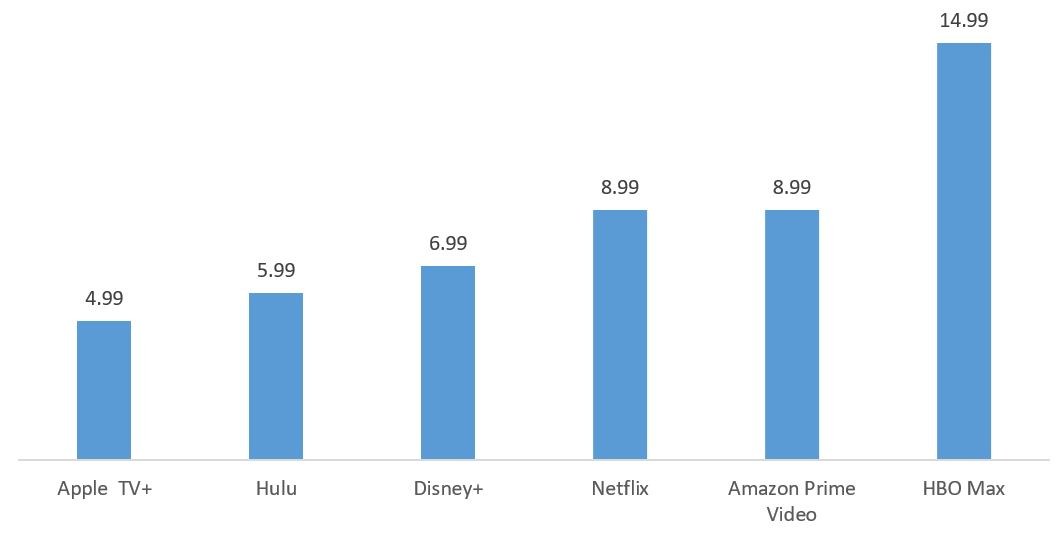
Source: Company Websites
Early signs of battle for content
‘Content’ would be the ammunition with which the streaming war would be fought in the coming decade and contenders with more ammunition would have an upper hand in this battle. |
The business strategy of all streaming service providers is more or less similar—advertise a new original series/movie on its platform to add subscribers and try to retain them with a library of old classics and popular rewatchable shows. As cancellation of services or switching to a different service provider can be done with just a couple of clicks, many people often subscribe to a platform for viewing a single title and discontinue thereafter. Hence, to survive fierce competition, streaming providers need to create original content fast and have an inventory of popular shows.
While all major players have a long pipeline of original content, they are jostling to obtain the rights of all-time hit TV shows as subscribers spend majority of their viewing time on licensed shows. Warner Media’s new platform, HBO Max drew first blood in the battle by acquiring the rights to stream Friends, the second most watched show on Netflix in 2018. NBC Universal acquired the rights of the most viewed TV show on Netflix, The Office. Although Netflix lost two of its most viewed shows, it acquired exclusive rights of the iconic sitcom Seinfeld, which used to air on Hulu. Fight for popular content is expected to intensify in the new decade, as new entrants would want to win rights of at least one-two iconic shows to kickstart their battle for making a mark in the industry. However, the battle would be tough to win as overspending on getting popular shows may impact their budgets for producing original content.
Number of first run TV series in Production (as of January 2020)
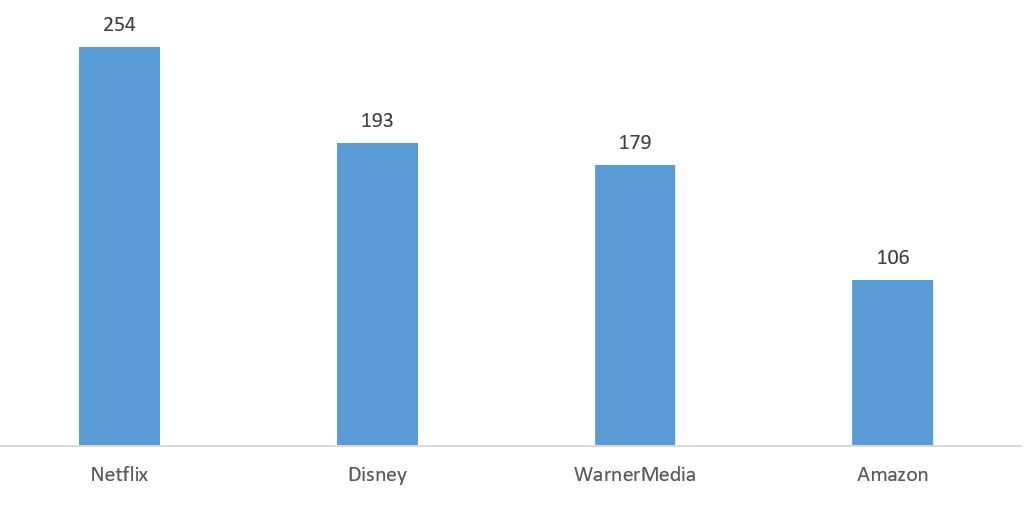
Source: statista
Fight to become one of the top two choices of every household
Since the inception of streaming, cable TV providers have been losing customers continuously. As per a report released by Leichtman Research Group (LRG), the proportion of households using cable TV in the US declined to 78% in 2018 from 87% in 2008. The trend seems to have continued in 2019—the largest pay TV providers in the US, representing roughly 93% of the market, lost nearly 1.5mn subscribers in the second quarter of 2019.
Although people are switching to online streaming platforms to view their favorite TV shows and movies, they still rely on cable TV or online TV subscriptions for live sports and news channels. Since there is no evidence of any negative impact on the popularity of these channels from the surge in the number of cord cutters in the US, live TV subscriptions are expected to be a part of most household budgets.
As per a research by LRG, in the US, the rate was about USD107/month per household for cable TV in 2018. Today, in 2020, live TV subscriptions in the country range USD30–70/month. Since most households would like to save on their monthly cable budgets, after subscribing to live TV, customers have room for subscribing to only one or two streaming services during a given month. Hence, the streaming platforms are engaged in a skirmish to be among the top two choices of every households.
US OTT Video Viewers, by Provider (in Millions)
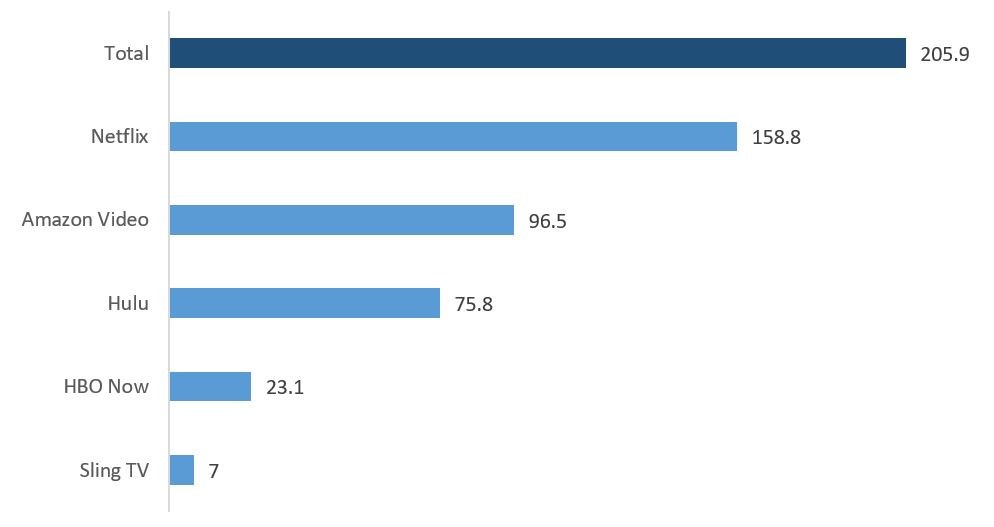
Source: eMarketer, July 2019
Strategy of players
Netflix: Going global with premium offering of regional and international original content
Netflix, the pioneer of streaming, commenced international expansion in 2010, just three years after its inception. The company focused on creating original content for almost every region it expanded into. In 2017, Netflix’s international subscribers surpassed its domestic subscribers. As of 2019, Netflix had over 167mn subscribers across 190 countries, with 63% of total subscribers in non-US countries.
Since the success of its first original series House of Cards, Netflix has evinced positive response from subscribers and critics for its original content. It has arguably been the most successful player in creating original content globally. Netflix is expected to continue its strategy of providing more and more original content. This is evident from its annual content budget of USD15 bn, which is significantly higher than that of other players in the industry—2.5 times higher than the content budget of Amazon Prime and Apple TV (USD6 bn each), and almost 6 times that of Disney+.
As of 2019, Netflix’s lowest subscription was available at USD8.99/month; it could go up to $15.99/month, a high premium vis-à-vis most peers. However, as Netflix has the highest number of titles in its library, highest content budget and a long pipeline of original content, customers are willing to spend a few extra dollars on subscription.
Netflix Number of Subscribers (in millions)
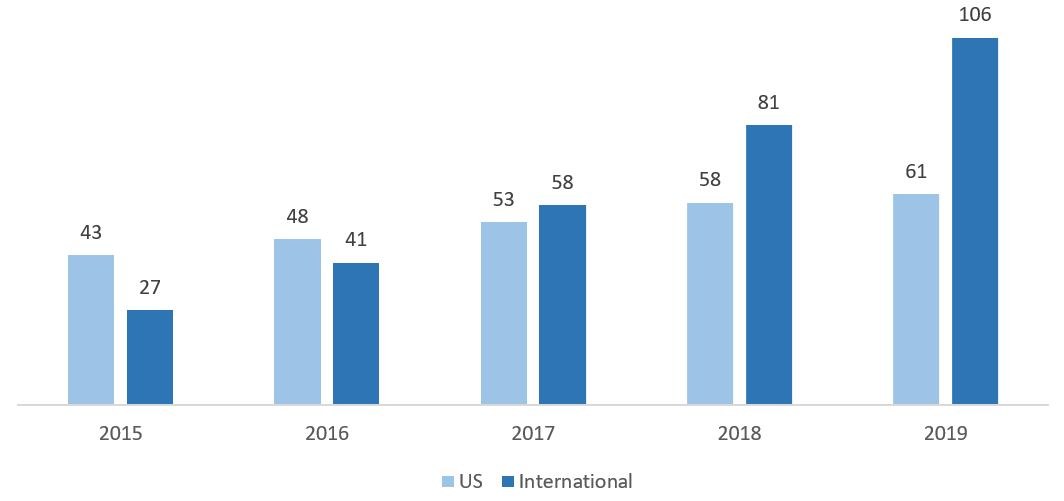
Source: Company filings
Amazon: Shopping benefits bundled with videos, music, books and much more
Amazon’s USP lies in its offering streaming services as an add-on benefit for the Prime members of its online shopping segment. By paying just USD8.99/month, Amazon Prime members get faster delivery of products and access to Prime Video services, rendering the company’s video services cost-free. Plus, Prime members can access Amazon Music and rent-free e-books on Kindle. Prime members can also subscribe to premium networks such as HBO and CBS by paying additional charge of USD4.99–14.99/month.
Given the preference for online shopping, Amazon plays a key role in catering to the daily requirements of households in the US. The company lures customers (for Prime subscriptions) by using offers on its online shopping website. Over the past 2–3 years, it has been spending heavily on creating original content to drive prime video viewership. Its current content budget stands at USD6 bn. Recently, it acquired the rights to make a TV series based on the popular book and movie series The Lord of the Rings for USD250 mn. Thus, its existing library, content in pipeline and online shopping benefits would make it very difficult for customers to cancel their Amazon subscription.
Amazon Subscription Revenue (in USD million)
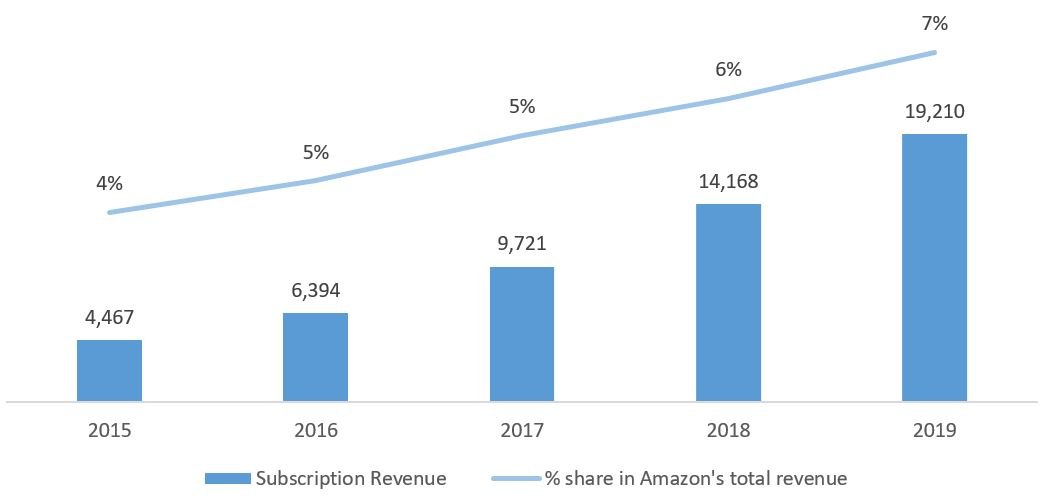
Source: Company filings
Hulu and Disney+: Combination is likely a game changer
Hulu is one of the prominent players in the industry, with the third largest viewership in the US as of 2019, after Netflix and Amazon. Previously owned by four giants – Disney, 21st Century Fox (Fox), Comcast and AT&T – in 2019, Disney acquired stakes of Fox and AT&T and took the control of Hulu.
Hulu started operations in 2008. It’s strategy, different from Netflix and Amazon Prime’s, rests on the two pillars of cheaper basic plan and live TV. Hulu’s cheapest plan costs just USD5.99/month, well below Netflix’s cheapest of USD8.99/month. However, it comes with commercials—to view add-free content, subscribers have to pay USD11.99/month. Since Hulu’s cheapest plan does not stream add-free content, the main attraction for subscribers is live TV, offered for USD44.99/month. Premium channels, such as HBO, Showtime and Cinemax, can be added for an additional cost of USD9–15/month. Also, Hulu has partnerships with big broadcast networks such as ABC, CBS, NBC and Fox, under which, it streams their shows on the following day after they premiere.
In 2019, Disney officially launched its streaming platform, Disney+, which showcases programs produced by Disney, Pixar and movies of all-time hit franchises such as Star Wars and Marvel. It would also feature National Geographic programs. As all these shows are very popular among children, Disney+ is expected to make its way to the monthly budget of most households in the US. Considering the fewer titles in its library, Disney has kept the monthly subscription of Disney+ at USD5.99/month. However, Disney recently launched a bundle package, which includes Hulu (with ads), Disney + and ESPN + at USD12.99/month. The bundle plan offers great value to customers as it effectively gives ESPN services at USD1/month. Thus, the combination of Hulu and Disney is expected to spice up the streaming war in 2020.
Apple TV+: Leveraging the success of iPhone, iPad and other devices
In November 2019, Apple launched its streaming platform Apple TV+ with nine original titles featuring popular actors such as Jennifer Aniston and Jason Mamoa. Since Apple has a very small library, it is charging a mere USD4.99/month for the streaming services, the lowest among all major players in the industry. Apple intends to leverage its market leadership in mobile phones, laptops and other devices to gain customers for its streaming platform. Apple announced a one-year free trial of Apple TV+ on purchase of new iPhone, iPad, Mac or Apple TV box. As per the Street, Apple is estimated to have sold almost 71mn new devices during the holiday season of 2019. Hence, by 2020, Apple would have almost 71mn new subscribers for its streaming platform. Apple would not earn any revenue from these subscribers for a year; however, considering its estimated expenditure of almost USD6 bn (annual content budget for 2020) on expanding its library of original shows, it is betting big on converting them at the time of renewal.
Other players
AT&T announced that HBO Max would be launched in May 2020, priced at USD14.99/month, same as the standard HBO subscription. With the launch of HBO Max, all the 35mn subscribers of standard HBO channel would get the HBO Max subscription. Additionally, premium unlimited wireless customers and top-tier home broadband customers would get access to HBO Max. The provider has purchased the rights of popular shows like Friends, The Big Bang Theory and The Wire to lure customers, but given the expensive price tag, this would be a difficult task for HBO Max. Therefore, AT&T’s management has projected a total subscriber base of 41mn by 2022, implying the addition of only 6mn new subscribers in two years following launch.
Comcast, the largest cable TV provider in the US, announced that it would enter the streaming market in April 2020 with its platform, Peacock. Peacock is expected to have a massive library as Comcast has signed deals with popular Hollywood studios to license their content. Peacock would feature movies produced by Hollywood’s biggest studios such as Universal Pictures, Focus Features, DreamWorks Animation and Lionsgate. In terms of pricing, Peacock has a similar strategy as Hulu. Peacock would be available in three price options: free, USD4.99/month and USD9.99/month. Free option would include access to a handful of movies and shows with commercials. The USD4.99/month plan would include access to Peacock’s library, but it would also include commercials. The USD9.99/month plan would give access to ad-free content.
Conclusion
With the entry of several new players, this decade will surely give more entertainment options to people than ever before. Availability of a wide variety options would prompt customers to switch their streaming provider more frequently. Since, content would be the key for subscriber growth in this crowded industry, oldest players such as Netflix, Amazon and Hulu seem to have a distinct advantage over new entrants like Apple, Peacock and HBO Max. It would be difficult for customers to resist the exhaustive library and upcoming original content of Netflix, or turn down the bundled benefits of Amazon Prime subscription. Hulu, with its partnership with Disney and ESPN, would be a natural choice for most families involving kids. Hence, we believe customers would stick with two of these three providers while switching between the new platforms based on trending shows and movies.

